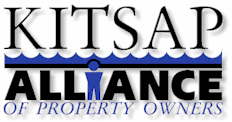by Dr. Don Flora PhD
A Look at Some Suspected Effects of Puget Sound Shore Protection
Speculation has it that bulkheads are hostile to forage fish and herring habitats, including upper-beach and eelgrass spawning places. Several recent studies address this issue. They’re important to protection planning for both shorelines and fish.
Three studies, by different analysts, have examined whether nearshore habitats are regularly associated with, or regularly absent from, the close vicinity of bulkheads. A negative association implies, but does not prove, hostility between habitats and shore protection.
The North Sound – The San Juan Initiative, working with a consultant, selected case study area on the four largest San Juan Islands, totaling 651 parcels along 34 miles of shore.[1] With that data a staffer at the Friday Harbor lab has determined[2] that there is a slight positive association between bulkheads and eelgrass and between bulkheads and forage-fish habitat.[3]
The Central Sound – In their recent shoreline inventory Bainbridge Island’s staff divided Island shorelines into 201 “reaches”, with data collected for each reach on installed structures and other indicators of human occupation, and on measures of habitat presence and density.[4]
An analyst (me) used this data and in four kinds of analyses[5] found near-zero relationships between bulkhead intensity, eelgrass and forage-fish habitats.[6] That result suggests that shore protection is neither good nor bad for habitats.
The South Sound – That the sedimentary environment was not affected by shore protection was shown in a study of Thurston County beaches, where 29 profiles of bulkheaded sections were compared with nearby non-bulkheaded profiles.[7] Beach “coarsening” and/or profile changes would be considered unfavorable for forage-fish spawning. No statistically significant coarsening was found.[8] Following adjustment of an analytical glitch, no statistically significant profile changes were shown. Eelgrass differences were not examined.
The Issue of “Encroaching” Bulkheads – Current law requires that new bulkheads be built snug against the bank. There remain a number of bulkheads out on the beach. Some of this was by intent; some is the product of natural shore movement inland, with its accompanying lowering of beach profiles, leaving bulkheaded reaches stranded (albeit functional). Do these bulkheads inhibit habitat?
In the North Sound study “Only 21% of the shore modifications…were above the forage fish spawning band.”[9] Yet analysis showed a positive relationship with documented forage fish spawning.
In the Central Sound (Bainbridge Island) analysis “encroaching armoring” was found to have no negative relationship whatever with sandlance spawning habitat, surf smelt spawning habitat, nor eelgrass.
In the South Sound assessment all but six of the 29 bulkheads were offset from the bank, and average distance of 10 feet. Yet no significant habitat effects were found.
The peril attributed to encroaching bulkheads appears nonexistent in these studies.
{1] Coastal Geologic Services Inc. 2008. San Juan Initiative Protection Assessment – Nearshore Case Study Area Characterization. Bellingham.
[2] Using nonparametric analysis, including multidimensional scale analysis.
[3] Dethier, Megan. 2008. Multivariate Analyses of Shoreline Parcel Data from the San Juan Islands. P. 4 of Appendix 3 in Coastal Geologic Services 2008, above.
[4] The data was used and published by a contract-research firm as they identified priorities for shoreline ’restoration’: Williams, G.D., et al. 2004. Bainbridge Island Nearshore Habitat Characterization & Assessment, Management Strategy Prioritization, and Monitoring Recommendations. Sequim: Battelle Marine Sciences Laboratory.
[5] Graphic, simple regression, nonlinear regression, multiple regression.
[6] Flora, D. F. 2009. Evidence of Near-Zero Habitat Harm from Nearshore Development. Bainbridge Island. Processed and on the internet.
[7] Herrera Environmental Consultants. 2005. Marine Shoreline Sediment Survey and Assessment, Thurston County, Washington. Seattle.
[8] Defined by the analysts as “the result of relatively small sediment being winnowed away from the surface of a beach”. Herrera 2005, above, p. A-1.
[9] Coastal Geologic 2008, above, p. iv, 13.




